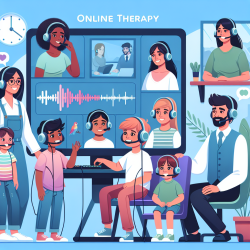As practitioners in the field of speech-language pathology, it is imperative that we continuously seek ways to improve our methods and outcomes for the children we serve. The recent issue of the Canadian Journal of Speech-Language Pathology and Audiology (CJSLPA) provides valuable insights that can guide our practice. This blog post will focus on key findings from the research article "Inter-rater Reliability of Clinicians Ratings of Preschool Children Using the FOCUS: Focus on the Outcomes of Communication Under Six" by Bruce Oddson, Karla Washington, Bernadette Robertson, Nancy Thomas-Stonell, and Peter Rosenbaum.
Understanding the FOCUS Tool
The FOCUS (Focus on the Outcomes of Communication Under Six) is a tool designed to measure functional changes in real-world communication associated with speech-language therapy. It aims to capture both the capacity and performance of children in various environments such as home, school, and social settings. The tool is administered through interviews with parents before and after treatment, making it a comprehensive measure of therapeutic progress.
Importance of Reliability in Outcome Measures
Reliability is a critical component of any outcome measure. A tool that lacks reliability cannot be trusted to provide consistent results, which can lead to inappropriate clinical decisions. The study in CJSLPA highlights the importance of establishing inter-rater reliability for the FOCUS tool. High reliability ensures that different clinicians can use the tool and obtain consistent results, thereby making the tool useful for both practical and research purposes.
Key Findings from the Study
The study evaluated the inter-rater reliability of the FOCUS tool by having pairs of clinicians assess 13 preschool children with speech-language impairments at two different time points. The results indicated an acceptable level of inter-rater reliability (ICC = .70), suggesting that the FOCUS tool is reliable for measuring changes in communication skills following speech-language therapy.
Implications for Practice
The findings from this study have several implications for practitioners:
- Consistent Measurement: The FOCUS tool provides a reliable way to measure communication outcomes, ensuring that different clinicians can obtain consistent results.
- Comprehensive Assessment: By capturing both capacity and performance, the FOCUS tool offers a holistic view of a child's communication skills in various settings.
- Data-Driven Decisions: Reliable outcome measures like the FOCUS tool enable practitioners to make data-driven decisions, improving the effectiveness of interventions.
Encouraging Further Research
While the FOCUS tool has shown promising reliability, it is essential to continue researching and validating such tools. Further studies could explore the tool's applicability to different age groups, settings, and types of communication disorders. By expanding our research efforts, we can ensure that our practices are grounded in solid evidence, ultimately leading to better outcomes for children.
Conclusion
The study on the FOCUS tool underscores the importance of reliable outcome measures in speech-language pathology. As practitioners, we must strive to incorporate such tools into our practice to ensure that our interventions are effective and data-driven. By doing so, we can make a significant impact on the communication skills and overall well-being of the children we serve.
To read the original research paper, please follow this link: Canadian Journal of Speech-Language Pathology and Audiology / Revue canadienne d'orthophonie et d'audiologie.










